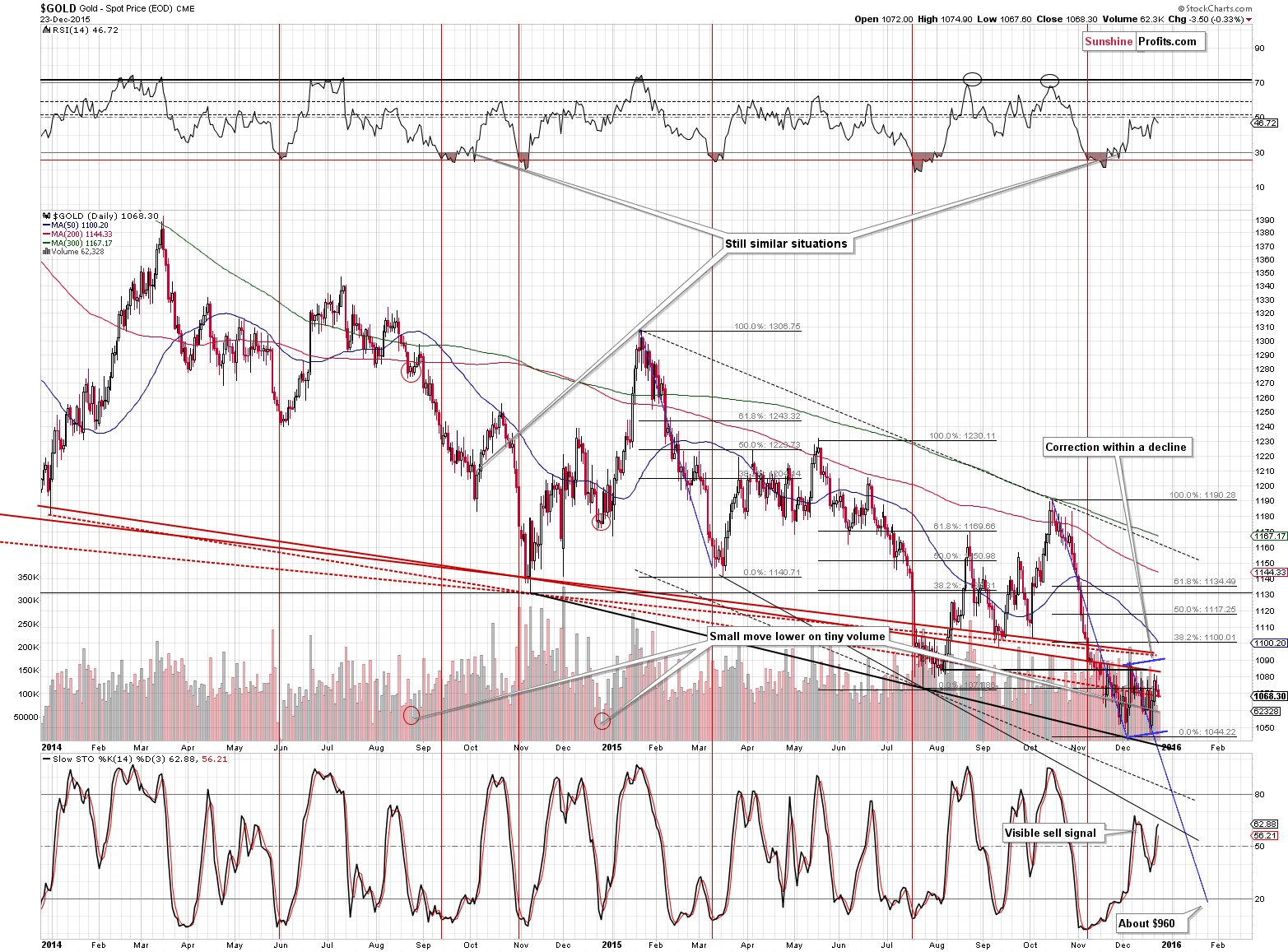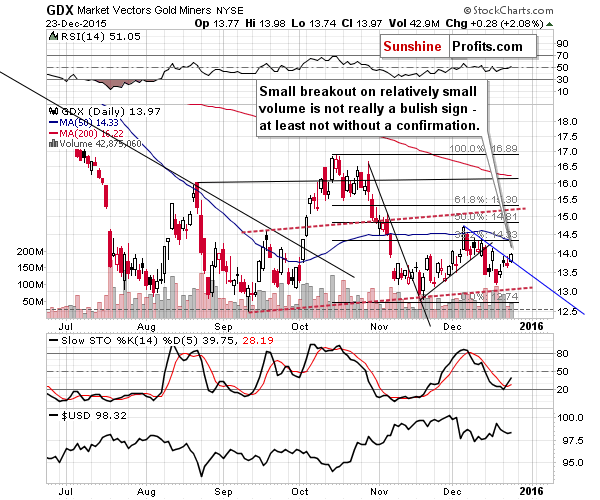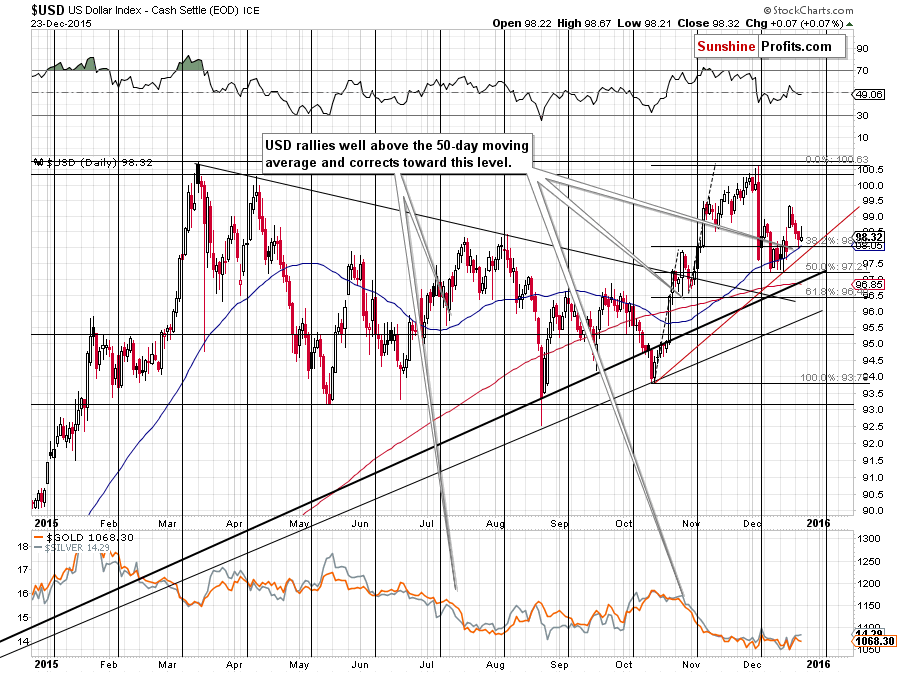Briefly: In our opinion, short (full) speculative positions in gold, silver and mining stocks are justified from the risk/reward point of view.
Not much happened in the precious metals market yesterday except for one important / “important” thing – the breakout of the GDX ETF above its short-term declining resistance line. What changed?
Not much. The move took place on relatively low volume, which makes the breakout very doubtful. Let’s take a closer look at the charts starting with gold (charts courtesy of http://stockcharts.com).

In short, our yesterday’s comments on the above chart remain up-to-date as very little changed (gold moved $3.50 lower yesterday):
Yesterday gold moved a bit lower on low volume, which is rather inconsequential (as a reminder, the implications of low volume are not symmetrical in case of rising and falling prices because of the way securities’ prices are set on exchanges). We saw something similar in late August 2014 (where prices declined a lot after a small move higher) and in December 2014 (where prices traded sideways for a few days and then moved higher). Overall, there are no certain implications of the yesterday’s price-volume situation.
Please note that even if the December 2014 situation repeats here, the price-volume link will likely show us that the tendency changed – note that in late December and early January 2015 gold rallied on significant volume and declined on small volume. We have not seen this kind of performance for several days in a row, so there are no bullish implications here.
There were no changes in silver as the white metal moved only 6 cents higher, so let’s move right to the action seen in the mining stocks sector.

We saw a small breakout in the case of the GDX ETF, but it was… well, small and the corresponding volume tiny. The volume was higher than on the previous trading day, but well below the volumes seen during upswings in the previous weeks and months. Consequently, we don’t view this breakout as confirmed by any means and we don’t think that the outlook changed much based on it.
Why did miners rally if it wasn’t for the “inherent strength” of the precious metals sector? The general stock market rallied yesterday, which is a very good and credible explanation. Consequently, there are little to none implications of yesterday’s move higher in mining stocks.

What about the USD Index? In yesterday’s alert we wrote the following:
The USD Index is in a particularly interesting situation right now. It’s after the visible comeback above the 50-day moving average and it moved back to it. Breakouts above this average have been important events and confirmations of these moves were important s well. There were only 2 similar cases in the past year and in both cases a rally in USD Index followed.
More importantly, these were the times right before the start of a major plunge in the precious metals sector, so we have yet another bearish confirmation.
The above remains up-to-date. The important thing regarding the above chart is that we adjusted the cyclical turning points for the USD. They now correspond to tops and bottoms in the USD Index to a much greater extend and thus are likely to provide us with more reliable signals in the future. This adjustment doesn’t have any implications for the current short-term outlook, though.
Can the USD Index move lower from here? Yes, but the downside is limited. The 50-day moving average provides support very close to the current readings for the index and the same is the case with the 38.2% Fibonacci retracement level. The rising red support line is a bit below the current price level, so there is some small downside from this perspective. Either way, even if the USD Index declines, it’s likely to decline a little. The short-term trend remains up and the outlook for the USD Index remains bullish. This, naturally, has bearish implications for the precious metals market.
Summing up, it continues to appear that we are right before a major decline in the precious metals sector and whether metals and miners continue to consolidate for a few more days or not, doesn’t change much. It seems that the profits on the current speculative short position will become much bigger – after all our target of $960 in gold is well below the current market price and if the analogy to the 2013 slide is indeed in place, then we will likely not have to wait long before this level is reached.
The upcoming year will likely start with major events in the precious metals world and paying extra attention to this market for the first few months should prove well worth it.
As always, we will keep you – our subscribers – updated.
To summarize:
Trading capital (our opinion): Short positions (full) in gold, silver and mining stocks are justified from the risk/reward perspective with the following stop-loss orders and initial target price levels:
- Gold: initial target price: $973; stop-loss: $1,107, initial target price for the DGLD ETN: $117.70; stop-loss for the DGLD ETN $81.84
- Silver: initial target price: $12.13; stop-loss: $14.83, initial target price for the DSLV ETN: $101.84; stop-loss for DSLV ETN $57.49
- Mining stocks (price levels for the GDX ETF): initial target price: $10.23; stop-loss: $15.47, initial target price for the DUST ETF: $31.90; stop-loss for the DUST ETF $10.61
In case one wants to bet on junior mining stocks' prices (we do not suggest doing so – we think senior mining stocks are more predictable in the case of short-term trades – if one wants to do it anyway, we provide the details), here are the stop-loss details and initial target prices:
- GDXJ ETF: initial target price: $15.23; stop-loss: $21.13
- JDST ETF: initial target price: $52.99; stop-loss: $21.59
Long-term capital (our opinion): No positions
Insurance capital (our opinion): Full position
Plus, you might want to read why our stop-loss orders are usually relatively far from the current price.
Please note that a full position doesn’t mean using all of the capital for a given trade. You will find details on our thoughts on gold portfolio structuring in the Key Insights section on our website.
As a reminder – “initial target price” means exactly that – an “initial” one, it’s not a price level at which we suggest closing positions. If this becomes the case (like it did in the previous trade) we will refer to these levels as levels of exit orders (exactly as we’ve done previously). Stop-loss levels, however, are naturally not “initial”, but something that, in our opinion, might be entered as an order.
Since it is impossible to synchronize target prices and stop-loss levels for all the ETFs and ETNs with the main markets that we provide these levels for (gold, silver and mining stocks – the GDX ETF), the stop-loss levels and target prices for other ETNs and ETF (among other: UGLD, DGLD, USLV, DSLV, NUGT, DUST, JNUG, JDST) are provided as supplementary, and not as “final”. This means that if a stop-loss or a target level is reached for any of the “additional instruments” (DGLD for instance), but not for the “main instrument” (gold in this case), we will view positions in both gold and DGLD as still open and the stop-loss for DGLD would have to be moved lower. On the other hand, if gold moves to a stop-loss level but DGLD doesn’t, then we will view both positions (in gold and DGLD) as closed. In other words, since it’s not possible to be 100% certain that each related instrument moves to a given level when the underlying instrument does, we can’t provide levels that would be binding. The levels that we do provide are our best estimate of the levels that will correspond to the levels in the underlying assets, but it will be the underlying assets that one will need to focus on regarding the sings pointing to closing a given position or keeping it open. We might adjust the levels in the “additional instruments” without adjusting the levels in the “main instruments”, which will simply mean that we have improved our estimation of these levels, not that we changed our outlook on the markets. We are already working on a tool that would update these levels on a daily basis for the most popular ETFs, ETNs and individual mining stocks.
Our preferred ways to invest in and to trade gold along with the reasoning can be found in the how to buy gold section. Additionally, our preferred ETFs and ETNs can be found in our Gold & Silver ETF Ranking.
As always, we'll keep you - our subscribers - updated should our views on the market change. We will continue to send out Gold & Silver Trading Alerts on each trading day and we will send additional Alerts whenever appropriate.
The trading position presented above is the netted version of positions based on subjective signals (opinion) from your Editor, and the Tools and Indicators.
As a reminder, Gold & Silver Trading Alerts are posted before or on each trading day (we usually post them before the opening bell, but we don't promise doing that each day). If there's anything urgent, we will send you an additional small alert before posting the main one.
=====
Latest Free Trading Alerts:
On Tuesday, crude oil gained 1.93% as a weaker greenback supported the price. As a result, light crude broke above the upper border of the triangle. Is it enough to encourage oil bulls to another test of the Aug lows?
Oil Trading Alert: Breakout and Its Consequences
=====
Hand-picked precious-metals-related links:
Gold price: Worries about Chinese, Indian physical demand
Why CSR makes sense for communities, companies and investors
=====
In other news:
Investors Pull Out of Mutual Funds at the Fastest Rate in Two Years
2015’s top-performing assets around the world
How to Be the Ultimate Contrarian Investor in 2016
=====
Thank you.
Sincerely,
Przemyslaw Radomski, CFA
Founder, Editor-in-chief
Gold & Silver Trading Alerts
Forex Trading Alerts
Oil Investment Updates
Oil Trading Alerts



